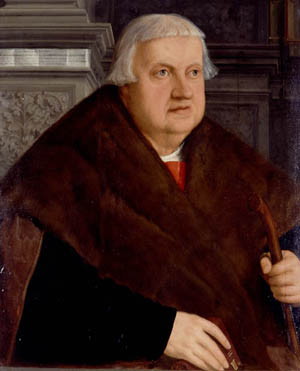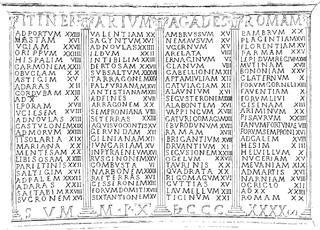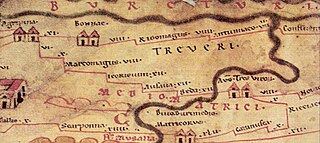
Conrad Celtes was a German Renaissance humanist scholar and poet of the German Renaissance born in Franconia. He led the theatrical performances at the Viennese court and reformed the syllabi.

Konrad Peutinger was a German humanist, jurist, diplomat, politician, economist and archaeologist, serving as Emperor Maximilian I's chief archaeological adviser. A senior official in the municipal government of the Imperial City of Augsburg, he served as a counselor to Emperor Maximilian I and his successor Charles V. Also known as a passionate antiquarian, he collected, with the help of his wife Margareta Welser (1481–1552), one of the largest private libraries north of the Alps.

An itinerarium was an ancient Roman travel guide in the form of a listing of cities, villages (vici) and other stops on the way, including the distances between each stop and the next. Surviving examples include the Antonine Itinerary and the Bordeaux Itinerary.

The Ravenna Cosmography is a list of place-names covering the world from India to Ireland, compiled by an anonymous cleric in Ravenna around 700 AD. Textual evidence indicates that the author frequently used maps as his source.
The earliest known world maps date to classical antiquity, the oldest examples of the 6th to 5th centuries BCE still based on the flat Earth paradigm. World maps assuming a spherical Earth first appear in the Hellenistic period. The developments of Greek geography during this time, notably by Eratosthenes and Posidonius culminated in the Roman era, with Ptolemy's world map, which would remain authoritative throughout the Middle Ages. Since Ptolemy, knowledge of the approximate size of the Earth allowed cartographers to estimate the extent of their geographical knowledge, and to indicate parts of the planet known to exist but not yet explored as terra incognita.
Richard John Alexander Talbert is a British-American contemporary ancient historian and classicist on the faculty of the University of North Carolina at Chapel Hill, where he was William Rand Kenan, Jr., Professor of History and is currently Research Professor in charge of the Ancient World Mapping Center. Talbert is a leading scholar of ancient geography and ideas of space in the ancient Mediterranean world.

The Geography, also known by its Latin names as the Geographia and the Cosmographia, is a gazetteer, an atlas, and a treatise on cartography, compiling the geographical knowledge of the 2nd-century Roman Empire. Originally written by Claudius Ptolemy in Greek at Alexandria around AD 150, the work was a revision of a now-lost atlas by Marinus of Tyre using additional Roman and Persian gazetteers and new principles. Its translation into Arabic in the 9th century was highly influential on the geographical knowledge and cartographic traditions of the Islamic world. Alongside the works of Islamic scholars – and the commentary containing revised and more accurate data by Alfraganus – Ptolemy's work was subsequently highly influential on Medieval and Renaissance Europe.
Savatra, Sabatra, or Soatra was a city in the Roman province of Galatia, and subsequently the Byzantine province of Lycaonia.

The Rauraci or Raurici were a small Gallic tribe dwelling in the Upper Rhine region, around the present-day city of Basel, during the Iron Age and the Roman period.
Trebula or Trebula Suffenas or Trebula Suffenes, was an ancient city of the Sabines, one of two bearing the name Trebula – Pliny being the only author who mentions both places: Trebulani qui cognominantur Mutuscaei, et qui Suffenates.
The Nantuates or Nantuatae were a Gallic tribe dwelling around present-day Massongex, in the modern Canton of Valais (Switzerland) and adjacent areas of France, during the Iron Age and the Roman period.
Caenophrurium was a settlement in the Roman province of Europa, between Byzantium and Heraclea Perinthus. It appears in late Roman and early Byzantine accounts. Caenophrurium translates as the "stronghold of the Caeni", a Thracian tribe.
Travel in classical antiquity over long distances was a specialised undertaking. Most travel was done in the interest of warfare, diplomacy, general state building, or trade. Social motivations for travel included visiting religious sites, festivals such as the Olympics, and health-related reasons. Most travel was difficult and expensive, due to the danger of violence, the scarcity of well-maintained roads, and the variability of travel times on water, as ancient ships were subject to the vagaries of both the wind and the tides.

The Roman road from Trier to Cologne is part of the Via Agrippa, a Roman era long distance road network, that began at Lyon. The section from Augusta Treverorum (Trier) to the CCAA (Cologne), the capital of the Roman province of Germania Inferior, had a length of 66 Roman leagues. It is described in the Itinerarium Antonini, the itinerarium by Emperor Caracalla (198–217), which was revised in the 3rd century, and portrayed in the Tabula Peutingeriana or Peutinger Table, the Roman map of the world discovered in the 16th century, which shows the Roman road network of the 4th century.

Ad Plumbaria was a civitas (town) of the Roman North Africa. The town flourished from AD 300-AD 640.
Melantias, often also Melantiada, Melentiana, Melitias, or Melitiada, was a settlement in Eastern Thrace in Roman and Byzantine times, near the city of Constantinople.
Virasia was a town in the west of ancient Pontus, inhabited in Byzantine times. According to the Tabula Peutingeriana it was on the road from Antoniopolis through Anadynata to Amasia, 16 M.P. from the latter.
Clannuda or Klannouda was a town of ancient Phrygia, inhabited in Hellenistic, Roman, and Byzantine times. It was mentioned in the Peutinger Table as Clanudda, which places it 30 M.P. from Aludda and 35 M.P. from Philadelphia.
Conium, also called Conni, Conna, Konna, Kone, Cone, Demetrioupolis and Demetriopolis, was a town of ancient Phrygia Magna. According to the Peutinger Table, where the town name appears as Conni, it was located between Eucarpia and Nacolea, 32 Roman Miles from Eucarpia and 40 from Nacolea. Pliny the Elder calls the town Conium; Ptolemy calls it Conna or Konna. Under the Byzantine empire the town was called Cone or Kone, and was a bishopric of Phrygia Salutaris, of which Synnada was the metropolis. No longer the seat of a residential bishopric, it remains, under the name Cone, a titular see of the Roman Catholic Church.










